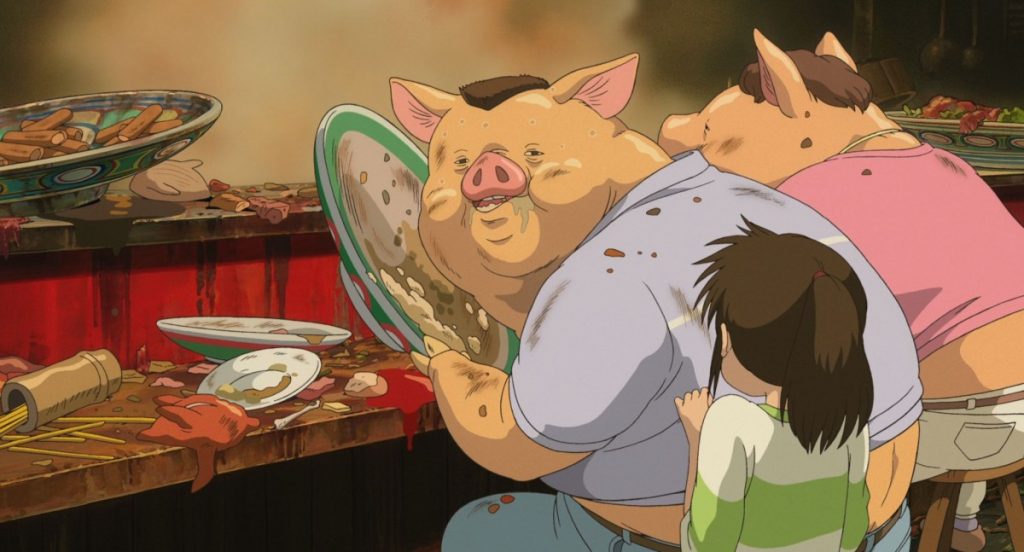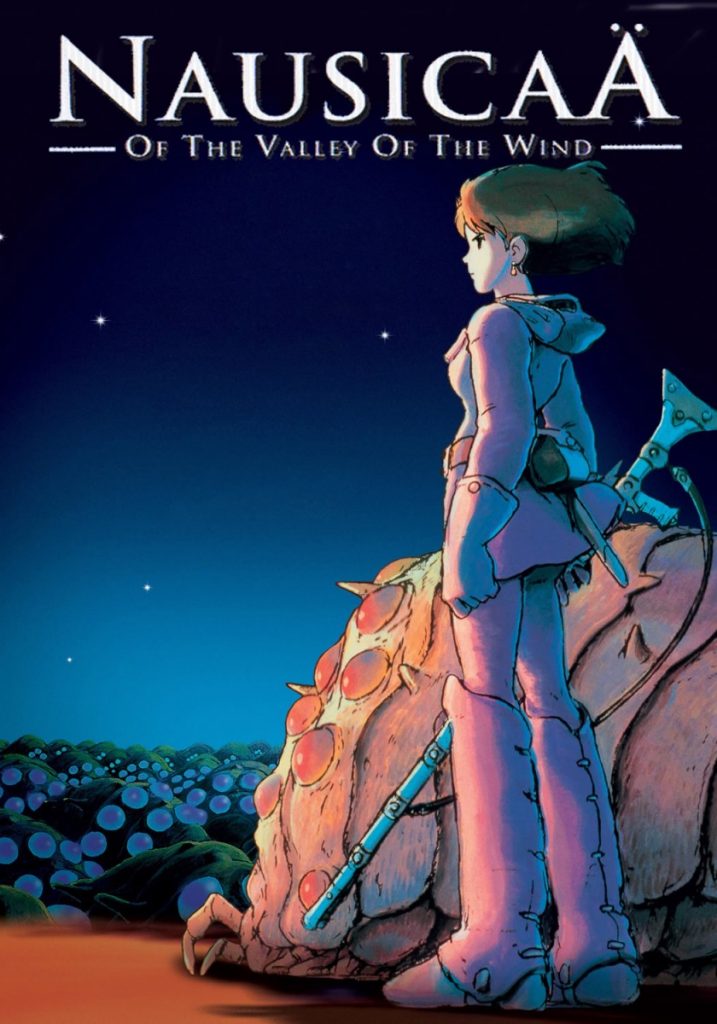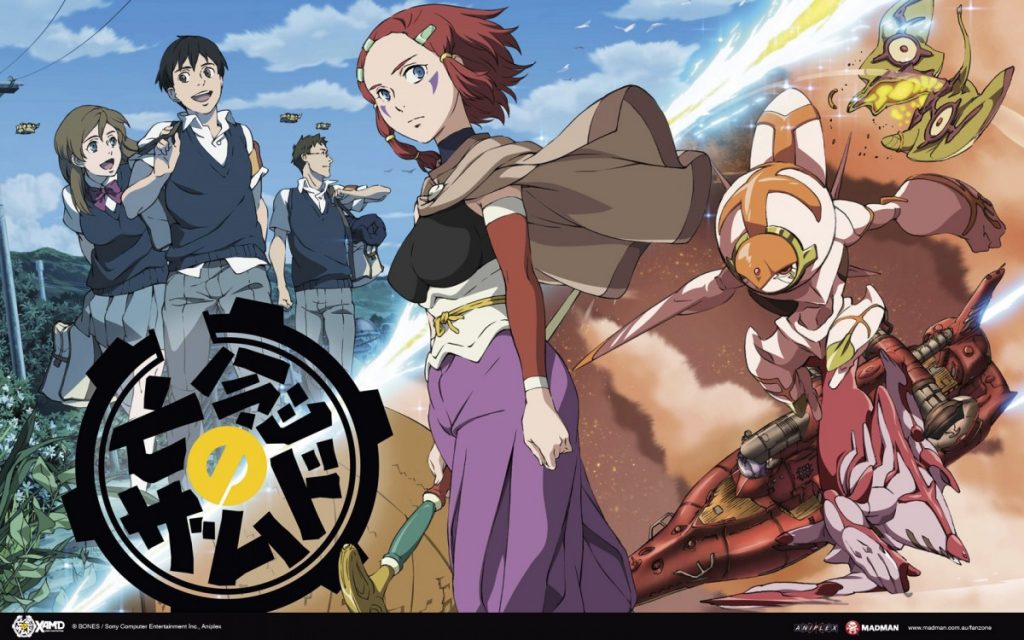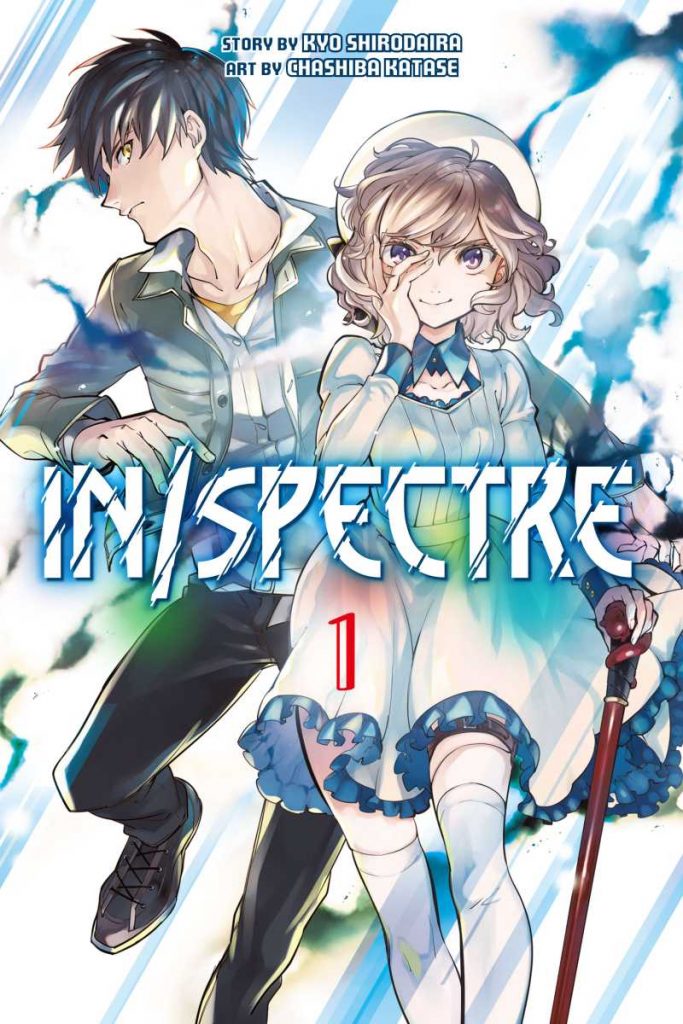For this post I decided to finally watch my “unofficial, official” introduction to anime, “Spirited Away”, which to myself feels like a homecoming of sorts and has added a new depth in how I view otaku culture and some things I had not known, and still wouldn’t know without Hayao Miyazaki’s work.

Chihiro and the river spirit Haku.
As I mentioned in an earlier post, I watched it when it first came out in the US when I was ten years old, and had a very had time watching it and Japanese animation in general afterwards because of this particular scene:

Scene in “Spirited Away” where Chihiro finds that her parents had turned to pigs, a result of their greed.
At the time I didn’t understand Miyazaki’s message with “Spirited Away”, about greed and his reoccurring themes/viewpoints about what industrialization and Japan losing its connection to its culture and past (plus his own struggles with his father being a part of that industrialization, embodied in aircraft, which Miyazaki also loved).
There are many levels and meanings to his works, some he is explicit about, others, like with all artists, can be inferred from what is seen, but it is never confirmed or denied. To me this means it’s something the viewer needs to seek out and understand themselves instead of having it hand fed to them. In other words, being told what it means would not have the same effect as understanding what it means.
I have found and many anime that have been influenced by it that I’ve watched over the years, such as in “Eureka Seven”, “Rahxephon”, and “Xam’d: Lost Memories”, where Miyazaki’s work in “Spirited Away” and “Nausicaa” can be seen, not just in design, but in themes as well. It should be noted that the three anime listed are all from Studio BONES, but have a heavier emphasis thematically on what we define as “human” and the role war plays into this on various levels.

Poster of “Nausicaa of the Valley of the Wind”, considered to be the foundation of Studio Ghibli’s existence.

“Xam’d: Lost Memories” wallpaper featuring the main character Nakiami, whose name is said to mean “no more tears”.
While digging into Miyazaki’s works, currently “My Neighbor Totoro”, I started looking deeper into Japanese folklore, such as yōkai (妖怪) or supernatural monsters, demons and spirits. This was prompted by trying to find out what “No Face” (or “Noh Face”) is (he’s not a traditional spirit, but made up for the film “Spirited Away”).
For my paper, I don’t know how in depth I will go into traditional Japan folklore (there is already too much going on), I believe that my own experience in exploring deeper into Japanese culture that is not anime and manga related, but I would have never been introduced to without it and otaku culture, is a prime example of how mislead mainstream culture is about otaku, and anime and manga in general.
Sticking with the example of yōkai, and my own work on looking for existing disabled/would be considered disabled protagonists that are strictly outside of the “easy” genres of drama, romance and comedy (so action, science fiction, adventure and fantasy), I came across a manga series called “In/Spectre”, first published in 2015 with the main story line complete and a sequel series to come:
“Both touched by spirits called yōkai, Kotoko and Kuro have gained unique superhuman powers. But to gain her powers Kotoko has given up an eye and a leg, and Kuro’s personal life is in shambles. So when Kotoko suggests they team up to deal with renegades from the spirit world, Kuro doesn’t have many other choices, but Kotoko might just have a few ulterior motives …,” – Kodansha Comics description.

Volume One cover of the manga series, “In/Spectre”.
I’ve read three of the current six tankōbon (単行本) or what generally stateside is considered a manga (漫画), though most are published chapter by chapter in magazines in Japan, such as “Weekly Shounen Jump”, prior to being collected together into volumes.
Initially I was browsing through the graphic novel section of Barnes and Noble, looking for a light novel I had seen there previously (it was gone…), and oddly this one caught my eye.
Now there are two things I want to go into on why I decided to go with this manga, when I had another one in mind originally.
One is how this manga, and other ones like it, are what I consider mark the beginning of a transition in taste, maturity and/or curiosity in causal to “weeaboo” type anime and manga fans.
Though from talking with other anime and manga fans I’ve found out that there are “weeaboos” who identify as a “weeaboo”, but would never identify as an otaku. The exact case is made by otaku who would never identify themselves as a weeaboo, but would admit to at one time being a “weeaboo”, the way a gamer would admit to being a “noob” or newbie at one time. So for here, I will use the term “weeaboo” to mean a “newbie” or inexperienced.
In “In/Spectre”, there are, well a lot of things going on. On the surface, it might seem like another supernatural type mystery series with a “Sherlock” and a “Watson” character, plus a third wheel to complicate things and the twist is the Sherlock using deduction character is a “Lolita” type girl and the Watson is an immortal and part yōkai, of course with a tragic backstory. And the whole yōkai part is to make it a Japanese version of “Supernatural”.
Except, that’s not how the story goes. First off, the yōkai are largely very friendly (and funny), sympathetic characters that Kotoko, the “Sherlock”, is their “Goddess of Wisdom”, that she volunteered to be at a very young age to be and to do so had to give up her eye and her leg to attain her “godhood”.
Also many of her “deductions”, are actually things she asks the yōkai she helps for information on, but since believing in ghosts, plus saying they told her this or that, would mark her as having a serious mental illness, so she gives Sherlock type explanations to those around her on how she knows this or that.
She also spends a lot of time at the hospital as well for ongoing treatment for her prosthetic eye and leg, so she would know very well how she would be treated if she had insisted that it was yōkai who kidnapped her and took her eye and leg, and didn’t let become the more believable story (in the context of the manga) that her initial explanation was to cope with the trauma of being kidnapped and her body mutilated as a child.
Also with Kotoko being a “lolita” type character, I was concerned that fan service would be an issue. Instead, the manga takes a more critical view on the scantily clad, large chested, anime idol types, by going into the life and death of a rising star just like that, who has come back from the grave as a ghost, with the case being centered around the idol’s normal life that lead to her death.
And without getting into too much detail, the “ghost” of her, the way the public saw/sees her, the faceless “idol”, is what is terrifying and wrong. This could be inferred as commentary on those types of characters prevalent in anime and manga, and the kind of effect is has on reality.
As for Kuro, or the “Watson” with a tragic back story, he isn’t considered human or yōkai, though he was originally human as a child until he was fed mermaid flesh unknowingly (not the Western mermaid), and in consuming the flesh of a yōkai, the yōkai became a part of him granting him immortality. But he is considered a monster by other yōkai, because he was fed the flesh of two types of yōkai and both of those became a part of him. So to the other yōkai he looks (and smells), like a detestable beast and they fear he will eat them too, even though he had no idea, or choice in what he became.
This manga also relates to disabilities, and society’s vs. the individual’s perception of what is a disability. Which is why I’m glad I found this graphic novel, which also touches on the what do we define as “human” like the BONES anime I mentioned.
In Kuro’s situation, his is feared by both humans and the yōkai who both don’t understand what he is and make assumptions, despite not being an enemy or threat to either. In fact helps protect yōkai and humans with the same abilities they fear, and the same abilities that have brought only disaster and trauma into his life.
With Kotoko, not only does she have to contend with a physical disability and the lifelong medical care it requires to live a “normal” life, she also has to keep it hidden how/why she lost her eye and leg, and that she can see and helps yōkai. If it were to be found out, she would be mark as, at best, with one of many mental illnesses that have as auditory and visual hallucinations, and delusions as part of their diagnostic criteria, like in the films “K-Pax”, “A Beautiful Mind” or even “Shutter Island”.
Kotoko is also not considered human or yōkai, she stuck in between the two worlds as well, but unlike Kuro, Kotoko is able to “pass” as human, able to explain away being a goddess of wisdom to yōkai, can still get hurt, or die as proof she is wholly “human” and only the yōkai she helps would ever know otherwise.
While Kuro has to remind himself not to get hurt (he can’t feel physical pain), or else someone might see him instantly heal, or come back to life, and like his ex-girlfriend, leave him, while he has to plan ahead for spending an eternity alone or watching everyone he knows come and go while he stays. He also has to deal with being three different things, two types of yōkai and human, which makes it much, much harder to gain the trust of the yōkai, (actually impossible without Kotoko’s help) who would be the only ones he wouldn’t have to worry about losing to old age and time.
Going back to the transition of fans from causal to otaku, or inexperienced/immature to mature in their understanding of the larger pictures, history and culture behind anime and manga, this one is excellent because:
- It has criticism on fan service in anime and from a humanistic standpoint. What fan service that is there, is minimal and compared to other manga and anime, would be considered non-existent outside of the part that criticism it. More so should make the reader feel uncomfortable objectifying the idol character and promote them to think about the negative impact of fan service.
- It introduces, uses and explains Japanese folklore in the plot as more than just another supernatural force. In the back of the manga there is even a section explaining the different yōkai and things that were changed in the English adaptation of the manga, with an explanation plus insight into Japanese culture and language.
- While it starts off with simple premise, the mystery starts to draw you in, and throughout there is talk about the characters, including the ex-girlfriend who is now a cop in a “backwater” type city, moving past their past and the past traumas (but Kotoko still has no issues with scaring and pranking the ex-girlfriend using the yōkai, once she moves past her own pride as needs hers, and not just Kuro’s, help too).
- A lot of the story revolves around the ideas of perception, assumptions and questions what is and is not true, in regards to the internet and also other people. But it’s not as heavy or dark as anime like “Psycho Pass”, which opens it up to a larger audience and (as far as I can see) isn’t a rehash of another popular manga or anime where it could be called a copy.
Which is where I come to the second reason why I am glad I found this manga. With how it deals with disability and the way it is perceived and defined by society vs. the individual who has it. What does it mean to be “disabled”?
So for this, I’m going to use a unique, or maybe less unique, condition I have that both helps and effects my everyday life called grapheme-color synesthesia.
This is a Ted-Ed talk to give a brief overview on synesthesia.
There is a lot of misinformation, not based on the experiences of those who actually have it. It is a heavily glamorized condition that in general is helpful and has no effect on day to day life for most, but for some, it can be overwhelming with other conditions, under certain circumstances and is a case by case scenario given that it completely subjective given that it effects perception and normally if a person has one form of synesthesia, it common to have one, two or even three more versions of it.
In my case, grapheme-color synesthesia is how I’ve always remembered words and numbers, they are all colors. Even in kindergarten I was annoyed at the alphabet cards pinned to the walls in the classroom because of things like the letter “B” was colored blue and to me it should have been brown and the “D” should have been blue. But in short to learn new words, I just memorized what color and color combinations they were to me.
While writing this I decided to look up how to memorize words and spelling, because I had never thought about or needed to be taught another way to memorize words. What I found, to me, was weird, tedious and stressful, like using sounds to memorize words.
It would never work for me because sounds also have a color, a specific shape they take and/or location. Like songs played on the piano ripple out in soft purples, blues and reds and electronic/synth music is normally yellows, blues and greens. In contrast, a crowded place like the mall, looks like a two year old scribbled over everything with brown, black and yellow crayons.
I’ve also included links/used sources from one of the Research Data bases Evergreen is subscribed to, Science Direct, to explain it:
“In synesthesia, stimulation of one processing stream (e.g. hearing) elicits concurrent experiences in a second, unstimulated stream (e.g. visual colors). In one of the most common forms, viewing numbers or letters (graphemes) elicits the percept of a specific color (Cytowic and Eagleman, 2009; Baron-Cohen et al., 1996), known as grapheme-color synesthesia. For example, to synesthete JC the number 2 always appears green, irrespective of its actual color. Synesthetic experiences begin in early childhood and remain extremely consistent over the lifespan.” – Magnetoencephalography reveals early activation of V4 in grapheme-color synesthesia: D. Branga, E.M. Hubbard, S. Coulsona, M. Huanga, V.S. Ramachandrana, University of California, Vanderbilt University